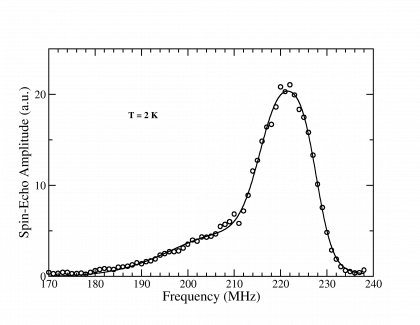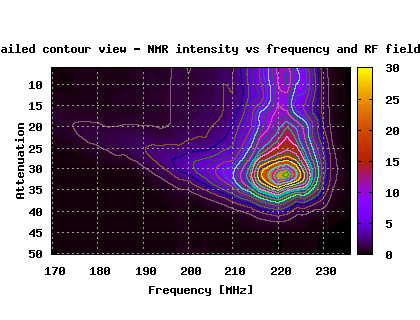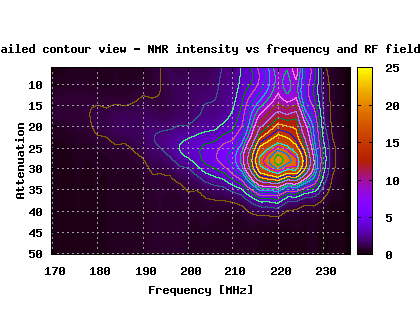Indice
59Co NMR spectra of Si/Alq3/AlOx/Co/Ta interfaces (Leeds)
NMR was used in order to probe the microscopic magnetic properties of the films, the microstructure at the interfaces and its possible compositional separation. The technique of spin-echo NMR allows the effective magnetic field (hyperfine field) at the nucleus to be determined and it is highly sensitive to changes in the local atomic environment and in particular to the parent atom's nearest neighbours.
Figure demonstrates 59Co NMR spectra acquired at T=1.6 K on multilayers Ta/Co/(AlOx)/Alq3/Si. Both spectra show the presence of a main resonance Gaussian peak at high frequency ~220 MHz consisting of a mixture of fcc Co (~217.4 MHz), hcp Co (~224 MHz), and stacking faults (distributed between fcc and hcp phases) and indicating a rather polycrystalline nature of the Co in the studied heterostructures. Because the shape of the main Co line of all spectra is the same, the relative amount of fcc Co, hcp Co, and stacking faults must be constant for the samples. Notice, however, that the intensity of the line for the film without barrier is much weaker, implying spoiled magnetic properties of the transition metal film which agrees with its reduced saturation magnetisation.
In Figure a typical 59Co NMR spectrum of the sample with the AlOx barrier is presented. An additional broad resonance line at lower frequency (~208 MHz) is observed. It should be noted that all spectra obtained in the samples with the thick buffer layer reveal the presence of a such broad peak centered at ~208 MHz. In order to understand its origin we must take into account that the replacement of a Co atom by a non-magnetic atom removes a hyperfine contribution at the nucleus, and that this contribution has been quantified in about 12-19 MHz per non Co nearest neighbour. This fact and the absence of the low frequency resonance line in the samples without AlOx spacer clearly indicates that the broad low frequency shoulder might be attributed to the Co atoms at an interface with the AlOx buffer layer, where some Co atoms are replaced by Al atoms in the nearest neighbour shell. It should be noted that the intensity and position of this broad interface line depends on the interface roughness. However, a difficulty for structural investigations by NMR arises from the indirect character of the structural information contained in the NMR spectrum. For detailed analysis of the interface roughness it is necessary to have a prior knowledge of the quantitative relationship between the hyperfine field and the local structure before any information can be drawn out of the measurements. Moreover in our NMR measurements no clear fine structure of the interface resonance line is observed, that also complicates such an analysis of the interface in terms of different nearest neighbour atoms and configurations.
From the relative intensities of the bulk and interface area, the amount of nuclei in the bulk and in the interface of the multilayers can be roughly estimated. Figure shows the dependence of the interface area to bulk area ration on the AlOx buffer layer thickness. In the multilayers without and with the thin (1 nm) AlOx barrier the ratio is zero and 0.1, respectively. The appearance of the low frequency satellite peak is rather abrupt and above 1-nm thick AlOx barrier this ratio is ~0.5 and does not depend on its thickness. This means that about 50% of the cobalt atoms is located at the interface layer(-s) and surrounded by one or more Al atoms when the thickness of the barrier exceeds 1 nm:
tAlOx = 0 - ~0% of the Co atoms with nearest neighbors of a different kind;
tAlOx = 1 nm - ~9% ;
tAlOx = 2 nm - ~45%;
tAlOx = 3 nm - ~49%;
tAlOx = 4 nm - ~51%;
tAlOx = 5 nm - ~48%
Such a dependence of the ratio on the barrier thickness might be explained as the following. In the absence of the AlOx buffer layer (or in the presence of a very thin one) cobalt tends to form clusters inside the top layers of the Alq3 rather than a continuous interface layer, leading to a reduced interface area which gives an insufficient contribution in 59Co NMR spectra. Introduction of the AlOx buffer layer between Alq3 and Co layer gives rise to the transition from the clustered superparamagnetic Co/Alq3 interface to the rather sharp ferromagnetic Co/AlOx/Alq3 interface with the thick AlOx barrier (tAlOx >1 nm). The assumption of the clusters formation in Co/Alq3 interface agrees well with the small value of the saturation magnetization Ms = 860 emu/cm3 and with the observation of superparamagnetic behaviour found in the same sample without AlOx barrier. Therefore, our 59Co NMR investigation of Ta/Co/(AlOx)/Alq3/Si hybrid structures also reveals the critical thickness 1-2 nm of the AlOx barrier below which ferromagnetism of the Co layer in these heterostructures is depressed.
As it was discussed above the degradation of the magnetic properties (namely, the saturation magnetization and the intensity of the main 59Co NMR line) in the sample without barrier can also be caused by the oxidation of a few Co monolayers in the vicinity of the Alq3 layer. However, we did not observed changes in the NMR spectra indicating their presence. Probably, a few monolayers of the aniferromagnetic CoO is not enough to be detected in our 59Co NMR experiments due to low enhancement factor of an antiferromagnatic phase. On the other hand, the resonance frequency of antiferromagnetic CoO is not well known and the corresponding resonance line might be beyond the checked frequency range.
Si/Alq3/AlOx/Co interfaces (t_Co = 15 nm, t_Alq3 = 50 nm; Bologna)
| Sample | Local H_an (bulk) | Local H_an (interface) | Coercive field |
|---|---|---|---|
| Ref. 2 | 17 Oe | ||
| A0 | 688 Oe | 421 Oe | 15.5 Oe |
| A1 | 16.3 Oe | ||
| A2 | 1632 Oe | 109 Oe | 15.5 Oe |















